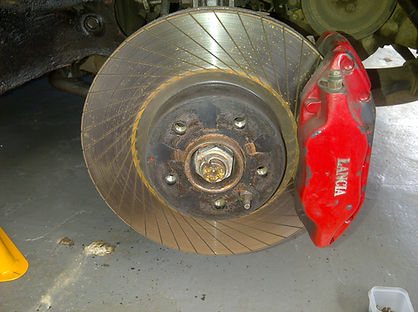
KEEPING
DELTAS
DRIVING
Lancia Delta Integrale specialists and enthusiasts
Rear calipers

We sold this nice Evo1 recently, it originally came from Japan. It had been stored for a while and needed
new rear brakes for its MOT, here's how we did it...
If a Delta isn't used, its rear calipers will often seize up. A brake caliper seizes when the piston rusts into its bore through not being moved, this can be fixed by removing the caliper from the car, removing the piston, and cleaning the piston and bore with a bit of very fine wet and dry paper, then shoving it all back, ideally with new seals
However, the Bendix or Lucas Girling units on the back of an Integrale are self adjusting, this operation is a combination of hydraulics and a corkscrew thread within the piston. A tab on the brake pad locates with a groove on the piston face, stopping the piston turning when the internal corkscrew automatically adjusts the brakes to compensate for the pad wear. The caliper also incorporates the handbrake mechanism, which mechanically applies the handbrake with a spring loaded lever.
All this makes the rear calipers difficult to service on a diy basis, taking them apart is ok, but resetting the piston on the screw, and adjusting the handbrake make reassembling them difficult, for me anyway! These are a safety critical item, and as such need to be set up properly, the long time it takes on the workbench is also a consideration.
As usual I decided to fit a new pair of these calipers.
So I removed the old units and took them to the local motor factors, they exchange the old units for remanufactured calipers from Brake Engineering. BE are a big and long established outfit in Wrexham, all motor factors know them and the components are high quality. BE didn't have any Lucas Girling calipers on the shelf, so ours were remade
and returned in a week.

These are the rear discs on the black Evo, the car was originally from Japan and had fancy discs fitted, you'll notice the long wheel studs also, to take a wheel spacer.
You can see the old caliper on the floor, the Evo calipers are a sliding, single piston design. These are a bolt on fitting where the securing bolts slide in the mounting, the older 16v design used a sprung wedge to locate the caliper and allow sliding movement.
The two types of rear brakes are not interchangeable, you need to
check your brake pattern before ordering.
Here is a newly fitted rear caliper on a
16v Delta, it has the sliding wedge mounting design, Evo models are bolt on.
The new caliper shown here is mounted in the frame with a wedge and spring top and bottom, with a securing pin through the wedge, it seems a bit insecure, but they
work well enough.

Our local motor factors is a CES branch, they sent the 2 calipers away to Wrexham, and they were returned in a week. The cost was £63 each plus vat, these calipers are available at about £150 each from the usual sources, but I don't know if these are new or refurbed.

The process of removing the old calipers isn't difficult.
The Evo1 mounting is a bit simpler than the 16v design, the Evo's caliper is secured with two bolts screwed into sliding sleeves, requiring a 15mm and a 13mm spanner.
The older 16v unit requires a screwdriver to pry the spring and release the pressure holding the L shaped sliding wedge, these are fitted top and bottom, if you release the top one, the bottom one is under less tension and is easy to remove.
The caliper action is the same on both models, a single piston presses the inside pad on the disc, then the pressure is
balanced by the caliper sliding in reaction pulling the
outside pad onto the disc.

Here's a video of the operation,
after the new calipers are fitted the brakes
need bleeding, this is shown too.
As per the fitting instructions, the handbrake cable isn't connected until the brakes are bled.
This is all shown in the vid.
The exchange calipers are well presented
and attractively packaged, the quality is
top notch. You know you're not getting a
Chinese imitation when you get your
own calipers back!
Let's talk about the front calipers a bit, on the Evo these are Brembo items.
These are high quality components which never seize, the stainless steel pistons
don't corrode. The caliper is a 4 piston design, rigidly attached to the hub frame,
it's strong and well balanced, and gives even braking forces.
The pads are easy to change, by simply withdrawing 2 pins the pads can be
pulled out, no unbolting is required.
The calipers bleed up nicely, with generous sized bleed nipples you can get
a decent sized spanner on, I love 'em!


